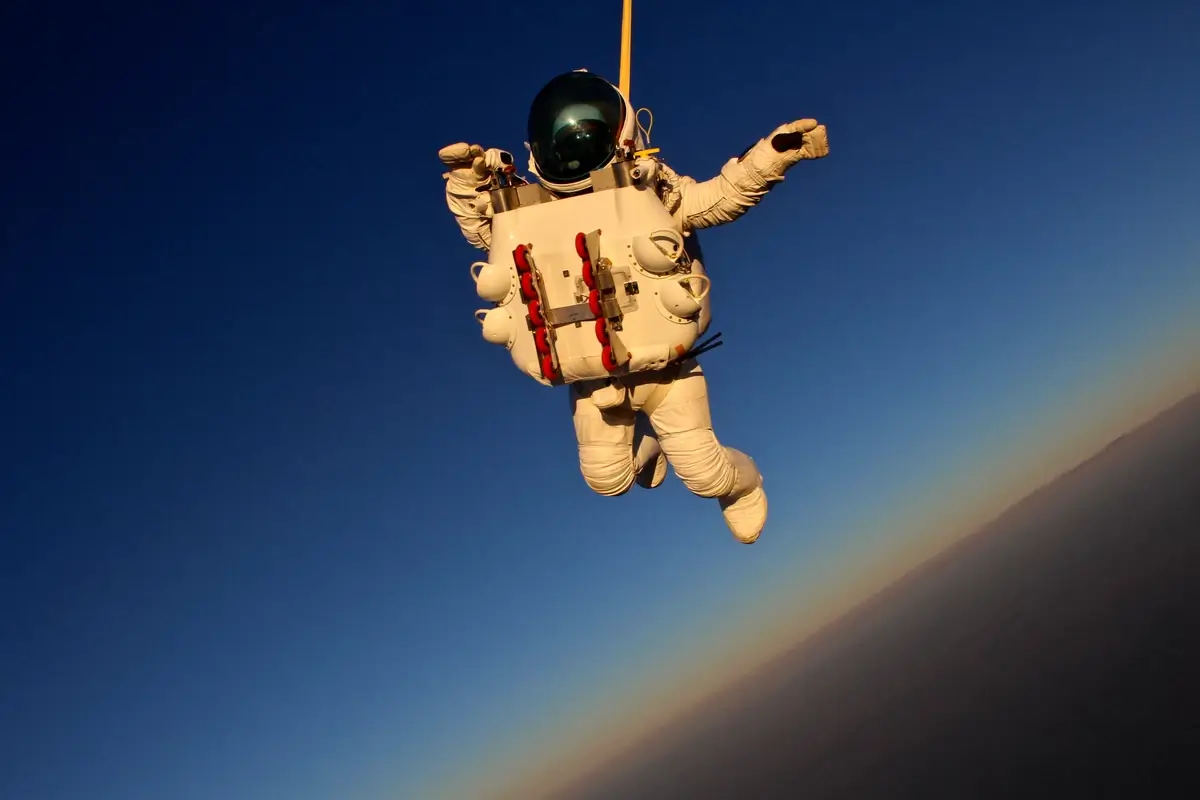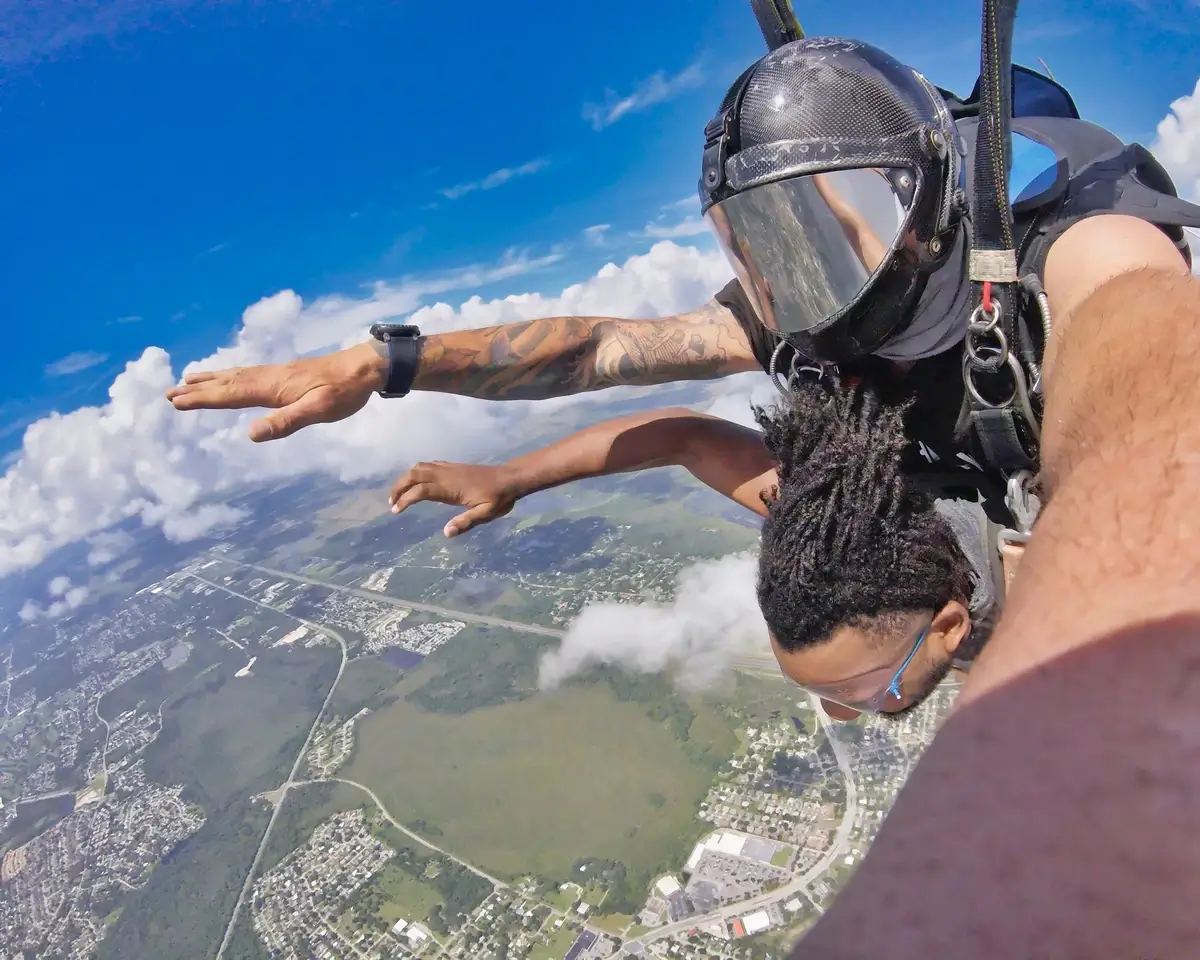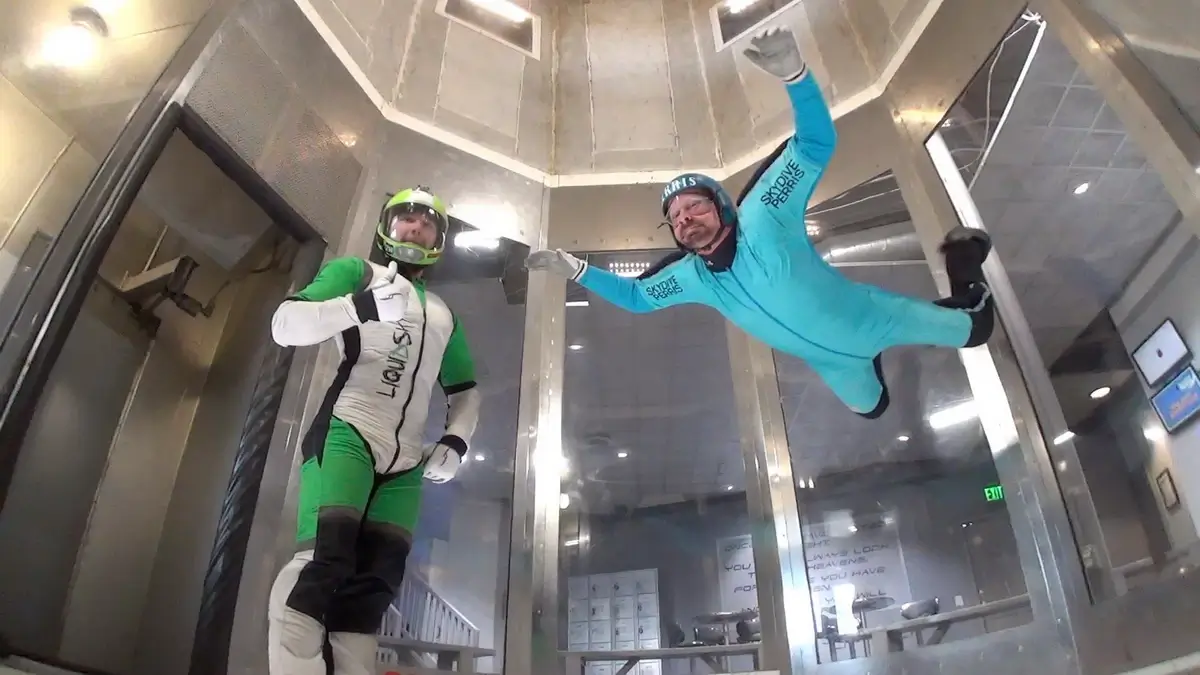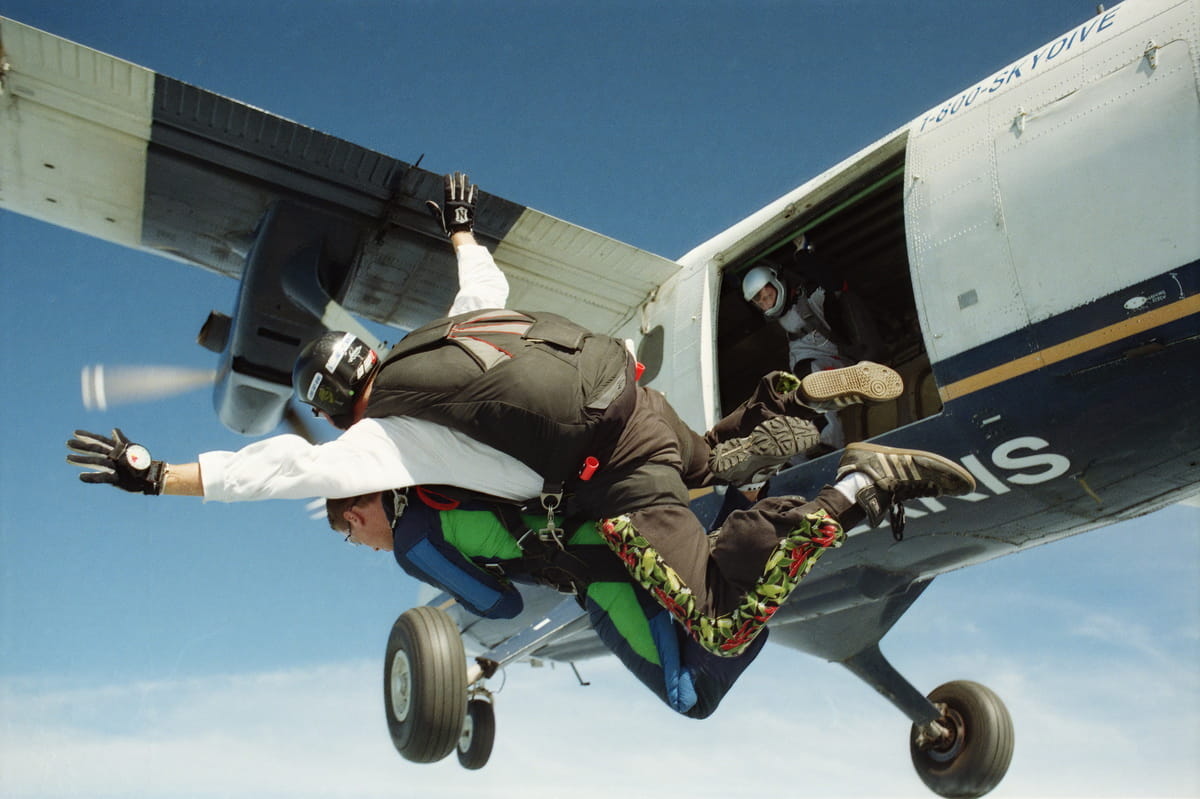Hey, you adrenaline junkies and curiosity cats! Ever found yourself daydreaming about jumping out of a plane with nothing but a parachute to cushion your descent? Well, you’re in luck! We’ve scoured the archives, consulted the experts, and even chatted with some sky-high daredevils to bring you 20 gasp-inducing, jaw-dropping fun facts about skydiving.
Whether you’re a skydiving newbie or a free-fall pro, we’ve got tidbits to tickle everyone’s fancy. So fasten those helmet straps, tighten those goggles, and make sure that parachute is packed. It’s time to dive—literally—into the enthralling world of skydiving!
1. First Parachute Jump by Andre-Jacques Garnerin
Turn back the clock to 1797. Picture yourself in the city of love, Paris, eyes fixed on a hot air balloon ascending to the sky. Tethered to it is a French adventurer by the name of Andre-Jacques Garnerin.
Garnerin leapt from the balloon with nothing but a silk parachute reinforced with wooden poles. He survived the descent and in doing so, marked the world’s first parachute jump. Garnerin not only defied gravity but also opened a new chapter in human exploration.

Image source: Wikimedia Commons
2. Alan Eustace’s Highest Skydive
Next up, a feat so high, you’ll need to crane your neck to see it. Meet Alan Eustace, a man who jumped from a staggering height of 135,890 feet in 2014. That’s higher than where most commercial airlines fly, folks!
Donning a custom-made spacesuit to withstand frigid temperatures and the thin air, Eustace didn’t just plummet back to Earth; he shattered the world record for the highest skydive ever recorded.

Image source: dailymail.co.uk
3. Skydiving Over the Swiss Alps
Skydiving in Switzerland isn’t just a whimsical experience; it’s a bucket-list activity with some remarkable credentials. Let’s talk facts: The jump usually takes place from heights of around 13,000 to 15,000 feet. Swiss skydiving companies like Skydive Interlaken and Skydive Switzerland are some of the only places where you can plummet over snowy Alps and land in a grassy meadow.
Interlaken, often dubbed the adventure capital of Switzerland, hosts over 14,000 skydives a year, becoming a significant hub for this exhilarating activity in Europe. The uniqueness of skydiving here? Well, you might experience temperatures that can dip below freezing even in the summer at those heights, so pack accordingly!

Image source: famoushostels.com
4. The Basics of Tandem Skydiving
So, you’re intrigued by skydiving but wouldn’t dare to go it alone? Enter tandem skydiving, the gateway drug for all you skydiving newbies. How does it work? You’re literally strapped to an instructor who knows what they’re doing (at least, we hope so).
The instructor does all the complicated stuff like steering the parachute, leaving you free to scream, laugh, or take in the views. It’s a great way to get a taste of skydiving without needing to master the whole rule book first.

ysmael pascual / Pexels
5. Freefalling Above Dubai
Dubai offers one of the most unique skydiving experiences in the world, and it’s not just because of the luxury hotels and high-end shopping. Skydive Dubai, a leading skydiving operator in the city, provides two primary drop zones: the Palm Drop Zone and the Desert Drop Zone. Each offers breathtaking views you won’t get anywhere else.
Dubai is also the host to international skydiving championships, including the Dubai International Parachuting Championship. The city’s skydiving fame was punctuated when they broke the world record for the largest flag flown while skydiving, measuring an astonishing 144.28 square meters. Talk about flying high in style!
6. Reaching Terminal Velocity
Speed demons, this one’s for you. When you skydive, there’s a point where you can’t accelerate anymore; you’ve hit what’s known as terminal velocity. For a human body in a belly-to-earth position, that’s about 120 mph.
Think about it: that’s faster than your car on most highways! You’re literally breaking speed limits… but in the sky, where the only traffic cops are birds.
7. Most Jumps in 24 Hours
For some people, once is never enough. The world record for the most skydives in 24 hours is held by Jay Stokes, who completed an astonishing 640 jumps back in 2006.
That’s roughly one jump every 2.25 minutes for an entire day! Forget binge-watching your favorite TV show; this guy binge-dives from the sky like a pro!
8. Skydiving’s Scientific Side
Skydiving isn’t just a joyride; it’s a real-world physics lab in the sky! One interesting point: the “Archimedes Principle” is often used in skydiving to explain why parachutes slow down your descent. When the parachute opens, it displaces air, creating an upward force opposite to gravity.
Let’s not forget the biological aspect. Skydiving can trigger what’s known as the “fight or flight” response. This primes your body for action, boosting heart rate and heightening senses. And once your feet hit the ground, that adrenaline still pumping in your veins can actually heighten your sense of relief and accomplishment.
9. Celebs Who Love to Skydive
You’re not the only one with sky-high ambitions; many celebrities are avid skydivers too! Tom Cruise performed his own stunts while skydiving in the movie “Mission: Impossible – Fallout.” He made over 100 jumps just for that film!
Then there’s Will Smith, who famously skydived to celebrate his 50th birthday, which was even live-streamed. Turns out, the rich and famous also love the thrill of falling from the sky.
10. Safety Stats of Skydiving
Skydiving may seem risky, but the stats tell another story. According to the United States Parachute Association, the fatality rate for skydiving is extremely low—about 0.0004% per jump in 2020. In fact, you’re more likely to get injured playing football.
Skydiving operators maintain stringent safety measures, including tandem skydiving for beginners and rigorous equipment checks. Feel better? You should.
11. Military Parachuting Debut
Believe it or not, parachuting didn’t start as an extreme sport—it was born out of military necessity. The first parachute jump of note for military purposes took place during WWII. In 1940, the 2nd Parachute Brigade of the British Army was created, and they made significant jumps including the famed operations in Normandy during D-Day.
Today, specialized forces like the Navy SEALs and Paratroopers continue to use skydiving as an essential part of their training and operations.
12. The Cost of Catching Air
Ever wondered how much it costs to defy gravity? Prices can vary widely based on location and the type of jump, but the average cost for a first-time tandem skydiving experience in the U.S. ranges from $200 to $300.
If you’re looking to get certified through the Accelerated Free Fall (AFF) course, prepare to shell out between $1,500 to $2,500. But hey, can you really put a price on feeling like Superman—even if it’s just for a minute?
13. Youngest Solo Skydiver: Age Matters
Now let’s dive (or rather, skydive) into the record books. If you’re itching to skydive solo, you’d better check your birth certificate first. In the United States, the minimum age for a solo skydive is 18. This age requirement is pretty standard globally, although some countries might have their own specific rules. Don’t expect to find any prodigious toddlers making the leap; skydiving is an adult game for a reason.
Why 18, you ask? Well, it’s mostly about safety and the ability to fully understand the risks involved. You need to be mature enough to grasp the gravity (literally and figuratively) of what you’re doing. Jumping out of an airplane isn’t like hopping off a swing set, after all.
14. The 103-Year-Old Skydiver
If the youngest solo skydiver impressed you, how about the oldest? Meet Al Blaschke, a 103-year-old who skydived to celebrate his birthday and set a world record for being the oldest tandem skydiver.
Age clearly has no limit when it comes to skydiving, as long as you’re medically fit. So, what’s your excuse again?
15. Weather’s Role in Skydiving
In skydiving, Mother Nature is the ultimate boss. Weather conditions can significantly affect skydiving operations. Low clouds can obscure visibility, and high winds can make both the jump and landing risky. Most skydiving centers will reschedule your jump if the weather doesn’t cooperate.
Even temperature plays a role; at 13,000 feet, the temperature can be about 30 degrees cooler than on the ground. So, layers are your best friend!
16. Levels of Skydiving Licenses
A, B, C, D—you might think we’re singing the alphabet song, but these are actually the levels of skydiving licenses issued by the United States Parachute Association (USPA). Here’s how it rolls:
“A” License: Requires at least 25 jumps and allows you to skydive solo without an instructor.
“B” License: This one demands a minimum of 50 jumps and a night jump qualification.
“C” License: Here, you’ll need at least 200 jumps and the ability to do certain maneuvers like accuracy landing.
“D” License: The top level, requiring 500 jumps. You also get the privilege to engage in specialized activities like wing suiting or base jumping.
Each level comes with its own privileges and responsibilities, ensuring you’re adequately prepared for the skies.
17. Train in a Wind Tunnel
Before you throw yourself out of a plane, you might want to try floating in a wind tunnel. It’s a great way to get acquainted with the sensation of free-fall without actually falling from a significant height.
Indoor skydiving facilities use powerful fans to lift you into the air, simulating the conditions of a real jump. It’s not just for rookies; even pros use wind tunnels for training!

Image source: skydiveperris.com
18. The 60-Second Freefall
A minute never feels as fast as it does when you’re free-falling from 13,000 feet! A standard skydive from this height usually involves about 60 seconds of freefall before you pull the parachute.
Believe it or not, those 60 seconds can feel like an eternity when you’re plummeting towards the Earth at around 120 mph. Time flies when you’re having fun, but it can also stretch when you’re awestruck!
19. Varied Skydiving Landings
Think all skydiving landings involve a dramatic slide or a roll? Think again. Many modern parachutes allow for surprisingly gentle landings—often so soft you can land standing up!
The type of landing often depends on the parachute’s design and the skydiver’s skill level. So, don’t be surprised if you see people nailing their landings like an Olympic gymnast.

Image source: skydivecarolina.com
20. Eco-Friendly Skydiving
Skydiving goes green? You bet! Some skydiving centers now offer eco-friendly skydives. From using biofuel in their planes to biodegradable smoke canisters for skydiving displays, the sport is getting a sustainable makeover.
The trend is still new but gaining momentum. In a world more conscious of its ecological footprint, even skydiving is adapting.
FAQ
What is the longest skydive in history?
The longest skydive in terms of altitude was accomplished by Alan Eustace, a Google executive. On October 24, 2014, he made a jump from an altitude of 135,890 feet, shattering the previous record set by Felix Baumgartner in 2012. Eustace was in freefall for approximately 4.5 minutes before deploying his parachute.
How many skydive jumps in a day?
The record for the most skydiving jumps in a single day is 640 jumps, set by Jay Stokes on September 8, 2006. This averages out to roughly one jump every two minutes for the entire day.
How rare are skydiving accidents?
According to the United States Parachute Association, in 2020, there were 11 fatal skydiving accidents out of an estimated 3 million jumps. This translates to a fatality rate of about 0.0004%.
What’s the hardest part of skydiving?
For many, the most difficult part of skydiving is making the decision to actually jump out of the airplane. The mental challenge of taking that first leap often overshadows the physical elements of the skydive.
Why skydiving is awesome?
Skydiving offers an unparalleled sense of freedom and adventure. The adrenaline rush from the freefall, coupled with breathtaking views of the Earth from thousands of feet in the air, make it a unique and thrilling experience.
Why does skydiving make you happy?
The physiological effects of skydiving, such as the release of adrenaline and endorphins, have been shown to boost mood and reduce stress levels. Researchers confirm that these chemical changes in the brain contribute to the post-jump euphoria many skydivers describe.
Does skydiving change your life?
For many people, skydiving is a transformative experience. It pushes individuals out of their comfort zones, offering new perspectives on life and challenges one’s limitations.
Does skydiving feel fast?
Though one might expect the experience to feel like a rapid plummet to Earth, many describe skydiving as feeling more like floating, especially after reaching terminal velocity. The perception of speed can vary from person to person.
Who invented skydiving and why?
The first documented parachute jump was made by Andre-Jacques Garnerin in 1797. Garnerin’s invention was initially conceived as a means to safely exit a malfunctioning hot air balloon. The concept has since evolved into the sport of skydiving.
What is skydiving safer than?
According to statistical data, skydiving is safer than driving a car, based on fatality rates. Other activities like cycling and even walking present higher risks of injury compared to skydiving, based on available safety data.














